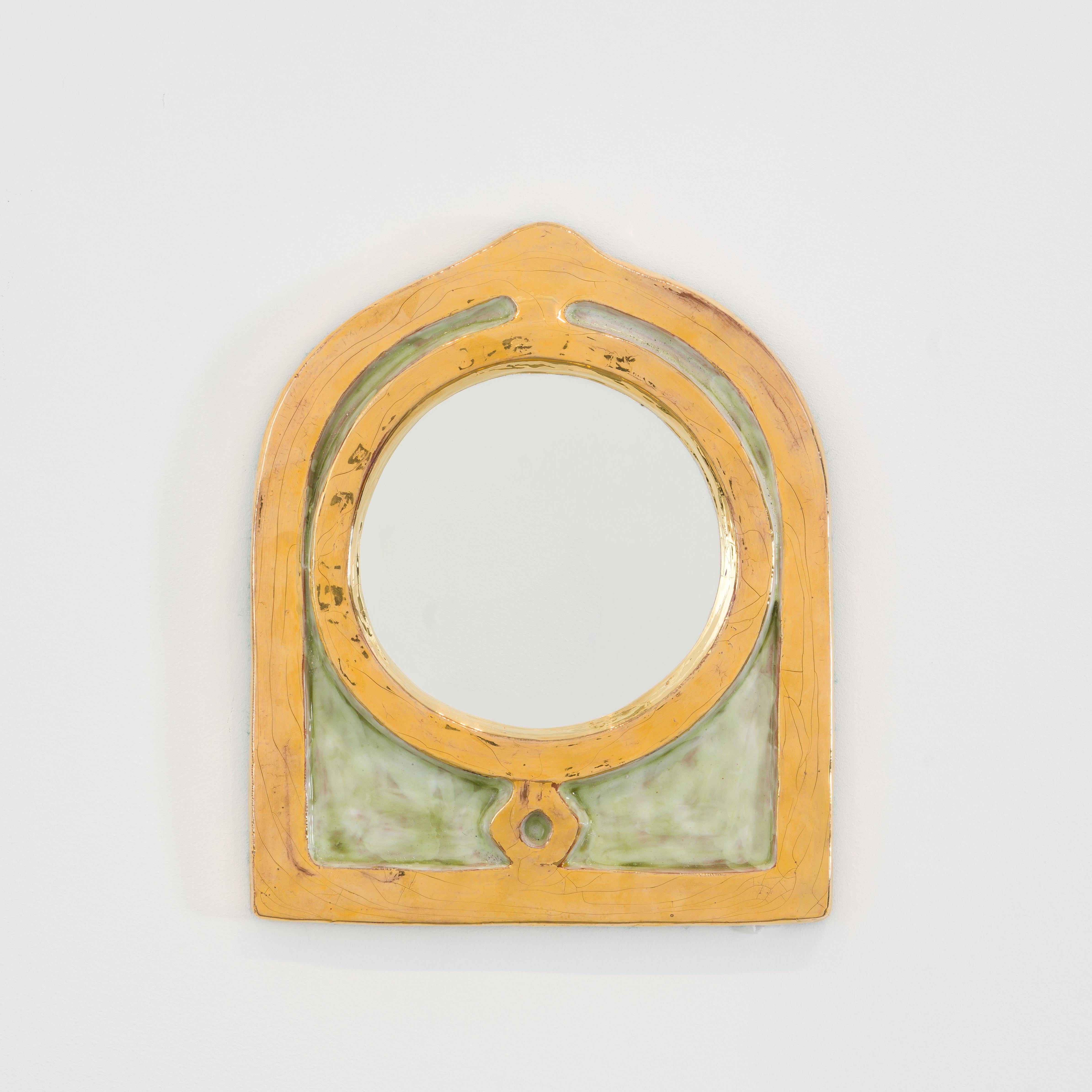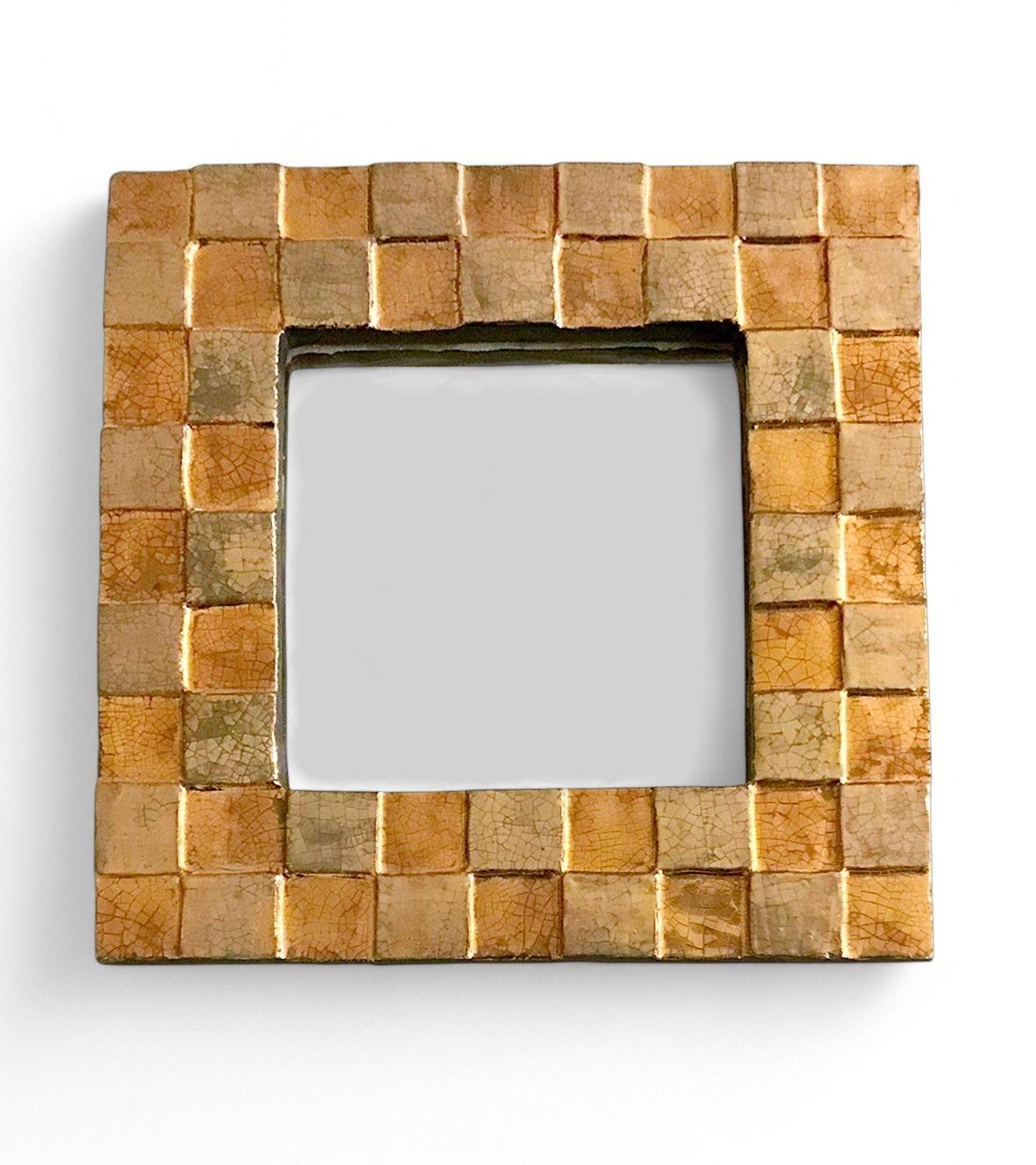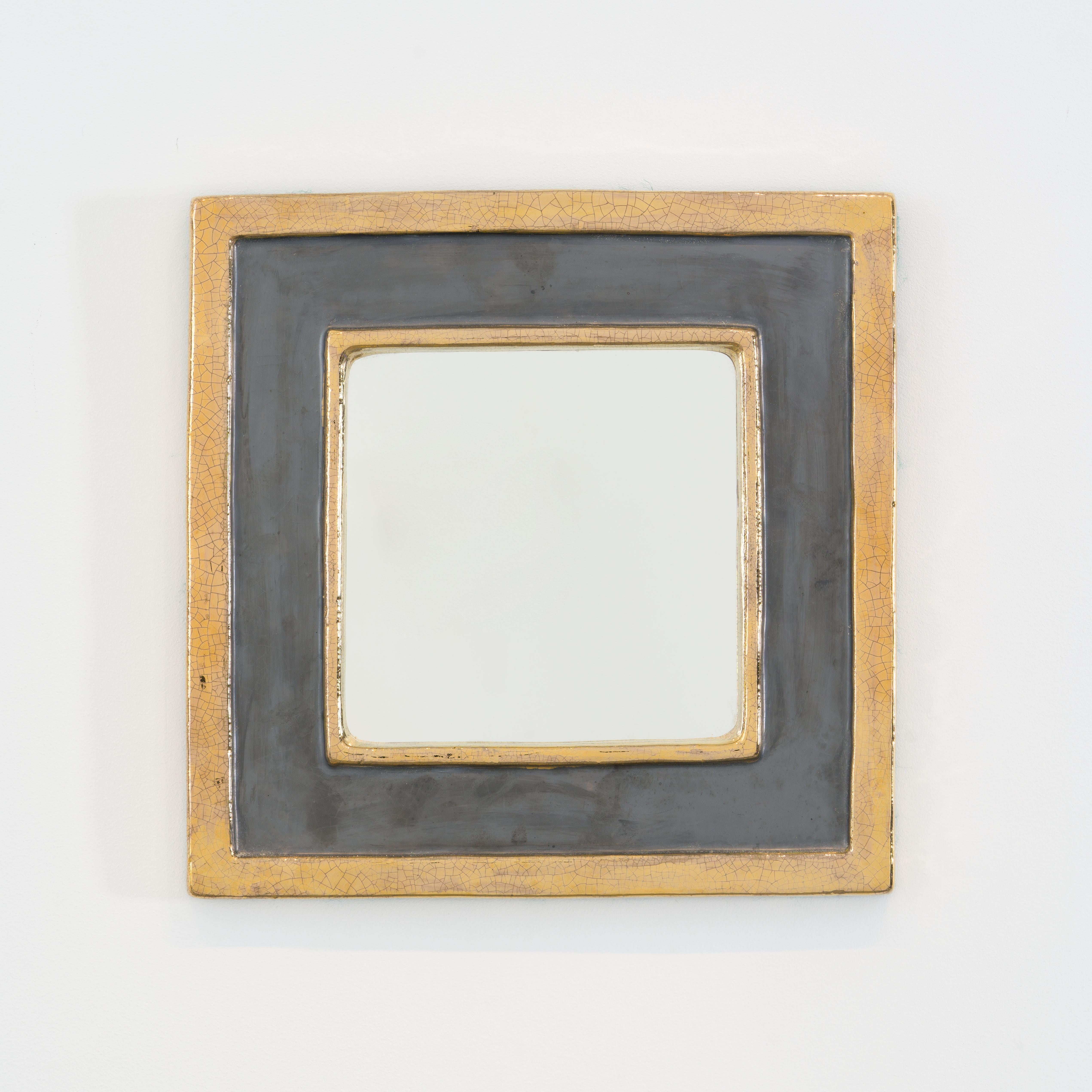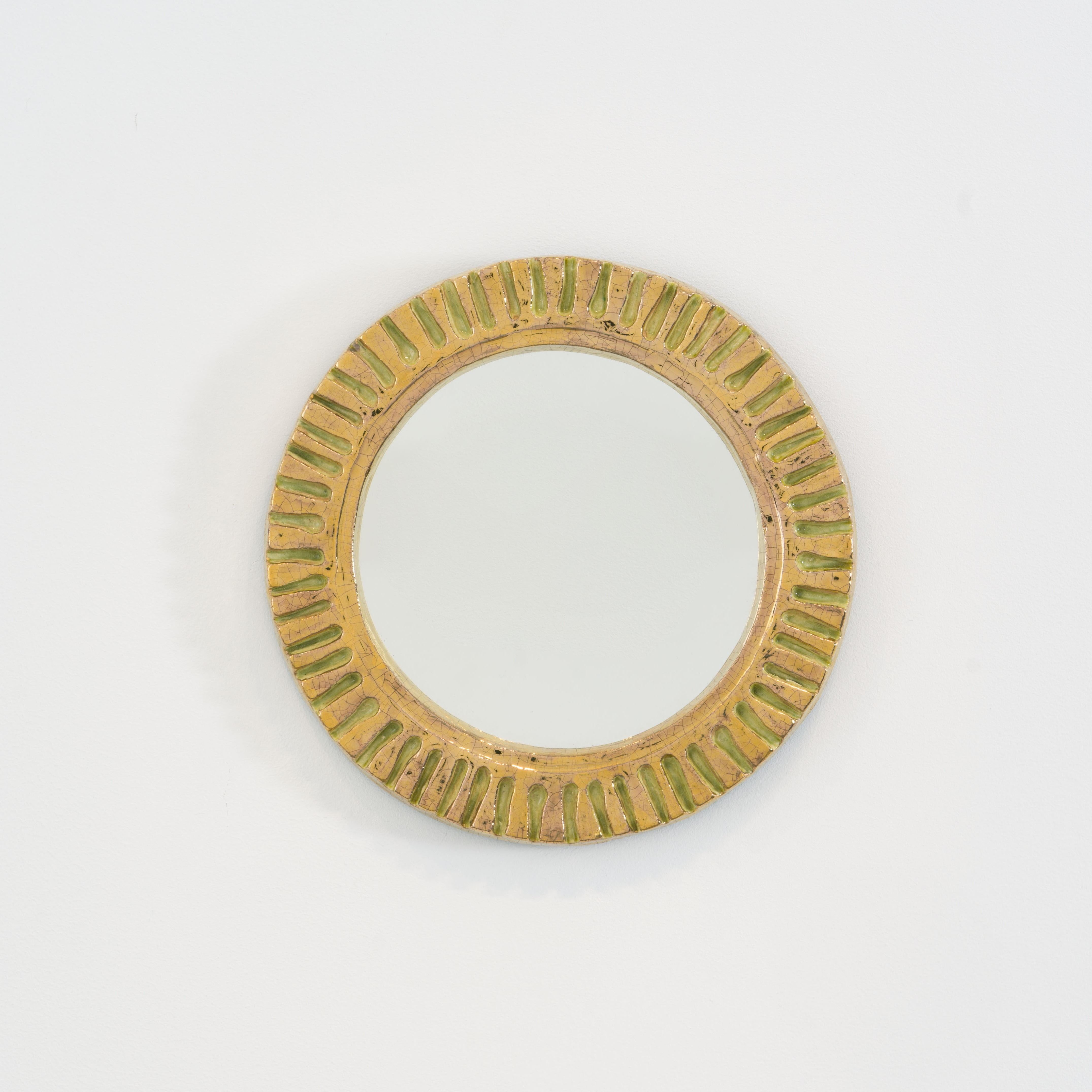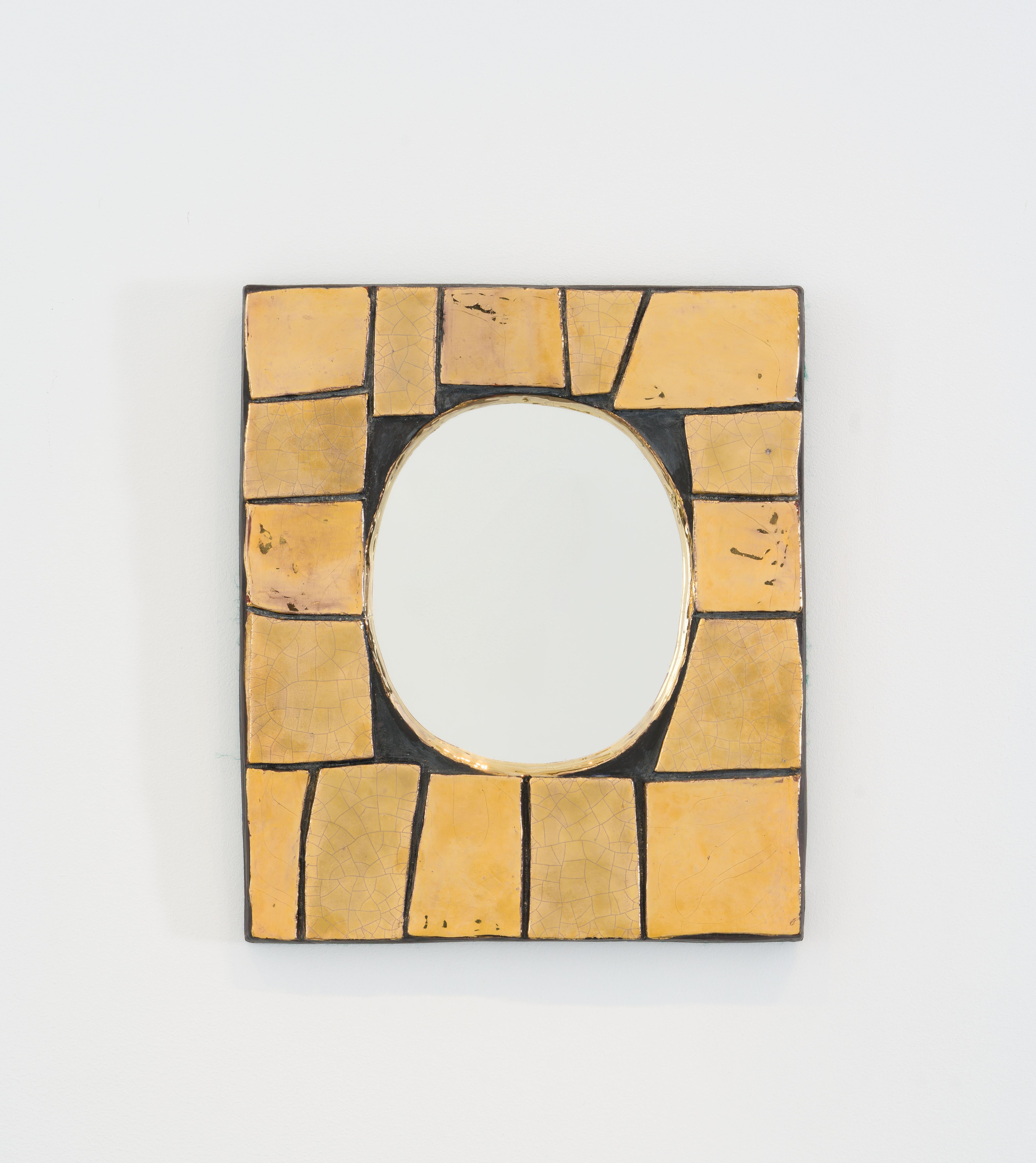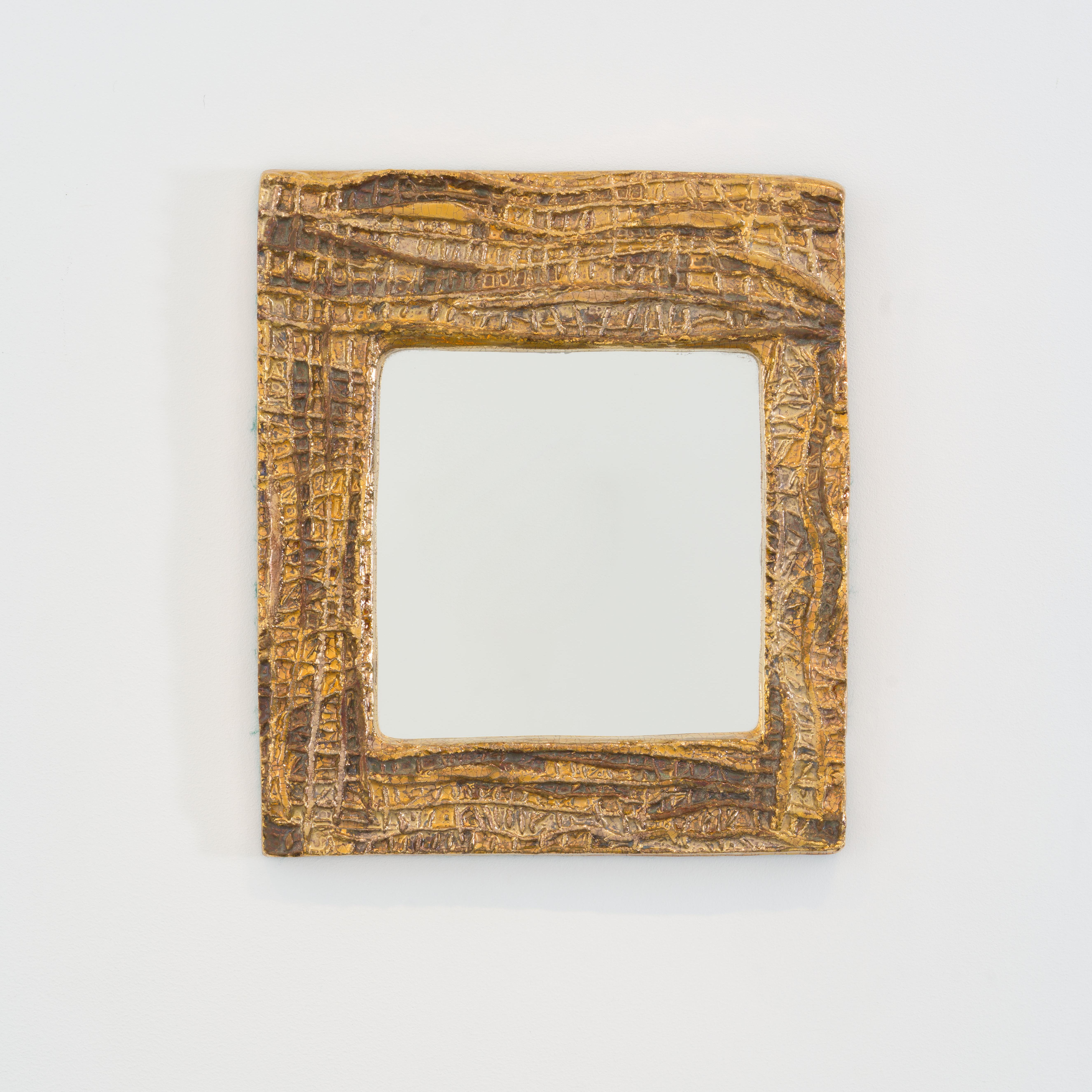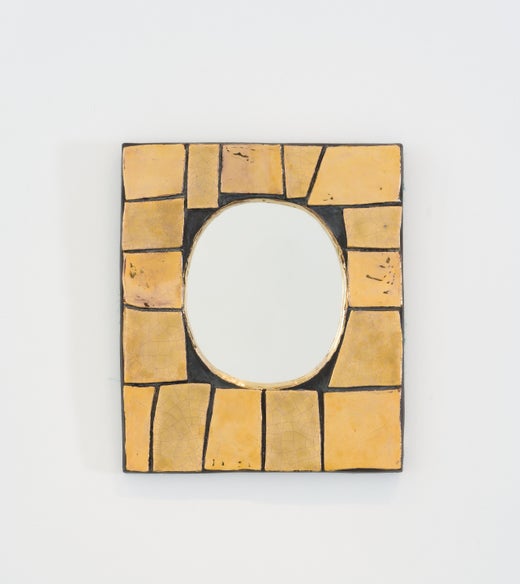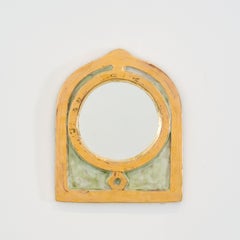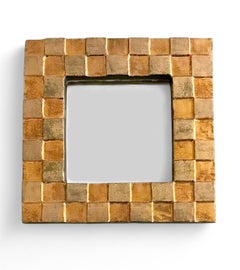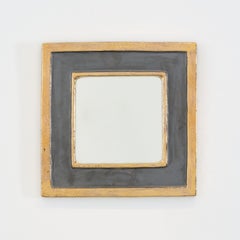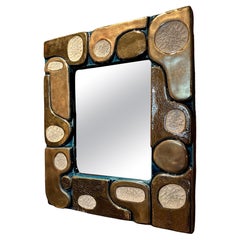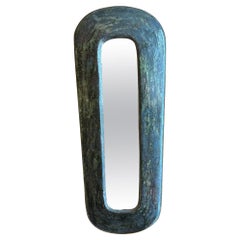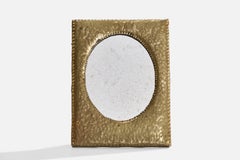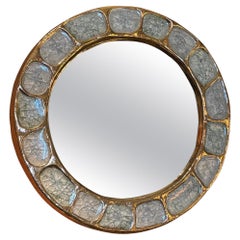Items Similar to Mithé Espelt Oblong Mirror in Embossed Earthenware with Crackled Gold, France
Want more images or videos?
Request additional images or videos from the seller
1 of 2
Mithé EspeltMithé Espelt Oblong Mirror in Embossed Earthenware with Crackled Gold, Francec. 1990
c. 1990
$6,576.04
£4,862.86
€5,500
CA$9,100.25
A$10,132.57
CHF 5,272.79
MX$122,298.23
NOK 66,125.70
SEK 62,459.89
DKK 41,882.80
About the Item
Emblematic Oblong mirror by French ceramist Mithé Espelt (1923–2020), originally designed circa 1949. This example was produced around 1990 under the direct supervision of the artist, using embossed earthenware and kiln-fired, crackled gold. The textured surface shimmers with subtle variations, a hallmark of Espelt’s unique synthesis of modernist form and artisanal technique. Known for bringing a poetic dimension to everyday objects, Espelt created mirrors that transcend function to become sculptural, luminous compositions. Rare and collectible, this mirror reflects the discreet luxury and spiritual resonance often found in her work. A standout addition to any interior: from refined bohemian to curated contemporary. Excellent condition. Accompanied by a certificate of authenticity. Illustrated on page 65 of the monograph "Mithé Espelt – The Discreet Luxury of the Everyday".
Mithé Espelt is a French ceramist whose work has long remained confidential, but is now enjoying a revival among 20th-century decorative arts and design collectors. Born in 1923 in Lunel, in the south of France, she grew up in an environment where art and crafts were central. After studying at the Beaux-Arts in Montpellier, she joined the artistic effervescence of Vallauris in the 1940s-1950s, a ceramics mecca where she rubbed shoulders with Pablo Picasso, Robert Picault and other major figures in the ceramics revival. Early on, she set herself apart by moving away from utilitarian pottery to explore more intimate, decorative forms. Far from the rustic ceramics and shiny glazes in vogue at the time, Mithé Espelt developed a singular technique combining finesse, texture and gilding. Her pieces, mainly mirrors, boxes, jewelry and small ornaments, are characterized by carefully worked surfaces and delicate graphic compositions. Her mirrors, undoubtedly her most emblematic works, do not just reflect an image: they become windows into a sensitive world, where gold, pastel hues and pure forms converse in harmony. Mithé Espelt has always cultivated a certain discretion. She did not sign her works, nor did she seek to enter the traditional art gallery circuit. Her creations were distributed on a confidential basis, notably by objets d'art boutiques and luxury houses. This absence of a signature contributed to her name going unrecognized for many years, even though her style was immediately recognizable. Today, her work is being rediscovered and appreciated for its singularity and timelessness. Her pieces, a combination of refined artistry and decorative art, embody discreet elegance and exceptional savoir-faire. Mithé Espelt reminds us that art can slip into everyday objects, transforming the simplest mirror into a work of art in its own right.
About the Seller
5.0
Vetted Professional Seller
Every seller passes strict standards for authenticity and reliability
Established in 1991
1stDibs seller since 2021
- ShippingRetrieving quote...Shipping from: Paris, France
- Return Policy
Authenticity Guarantee
In the unlikely event there’s an issue with an item’s authenticity, contact us within 1 year for a full refund. DetailsMoney-Back Guarantee
If your item is not as described, is damaged in transit, or does not arrive, contact us within 7 days for a full refund. Details24-Hour Cancellation
You have a 24-hour grace period in which to reconsider your purchase, with no questions asked.Vetted Professional Sellers
Our world-class sellers must adhere to strict standards for service and quality, maintaining the integrity of our listings.Price-Match Guarantee
If you find that a seller listed the same item for a lower price elsewhere, we’ll match it.Trusted Global Delivery
Our best-in-class carrier network provides specialized shipping options worldwide, including custom delivery.More From This Seller
View AllWall Mirror Arche #1 Mithé Espelt French Ceramist Crackled Gold Earthenware
Located in Paris, FR
Mirror Arche #1 by Mithé Espelt (1923-2020) is a rare and poetic example of the French ceramicist’s mastery of form, texture, and quiet symbolism. Crafted in the mid-1960s in her ate...
Category
1960s Mixed Media
Materials
Ceramic
Rare Wall Mirror by Mithé Espelt French Ceramist Glazed Earthenware and Gold
Located in Paris, FR
This rare square mirror by Mithé Espelt exemplifies the poetic precision of her ceramic work. It is covered in a lustrous gold glaze, fired directly into the enamel: a meticulous pro...
Category
1950s Mixed Media
Materials
Ceramic
Wall Mirror Mithé Espelt Embossed and Glazed Earthenware with Gold Highlights
Located in Paris, FR
This square-format mirror, crafted in glazed ceramic with a refined palette of deep grey and gold, exemplifies Mithé Espelt’s understated sophistication. Characterized by its minimal composition and luxurious finish, the piece offers a quiet yet powerful presence. The thick, raised border, richly crackled and hand-glazed, evokes both the elegance of mid-century modern design and the artisanal precision of southern French ceramic...
Category
1950s Mixed Media
Materials
Ceramic
Rare Glazed Ceramic and Crackled Gold Mirror by Mithé Espelt, France, circa 1948
Located in Paris, FR
Exceptionally rare and early mirror by celebrated French ceramicist Mithé Espelt, dating from around 1948. This striking piece, handmade in stamped and glazed earthenware with fire-g...
Category
1940s Mixed Media
Materials
Gold
Mithé Espelt Gilded Ceramic Mirror “Cuzco”, France, ca. 1970
Located in Paris, FR
This exceptional ceramic mirror by French artist Mithé Espelt (1923-2020) was handcrafted in her Lunel atelier circa 1970. Known for her singular ability to unite refinement and func...
Category
1970s Mixed Media
Materials
Ceramic
Wall Mirror Santa Fé #1 Mithé Espelt Embossed Earthenware Gold
Located in Paris, FR
The Santa Fe #1 mirror by Mithé Espelt is a striking example of the French artist's mastery in ceramic design, reflecting her unique blend of artistry and craftsmanship. Espelt is re...
Category
1970s Mixed Media
Materials
Ceramic
You May Also Like
Ceramic mirror "Ouvea" by Mithé Espelt, France, 1960's
By Mithé Espelt
Located in Paris, FR
Ceramic mirror by Mithé Espelt, Ouvea decor, France, 1970's
Category
Vintage 1970s French Modern Wall Mirrors
Materials
Ceramic
Ceramic Mirror by Juliette Derel, France, 1960s
By Juliette Derel
Located in Paris, FR
Ceramic Mirror by Juliette Derel, France, 1960s
Category
Vintage 1960s French Wall Mirrors
Materials
Ceramic
Italian Designer, Small Table or Wall Mirror, Hammered Brass, Italy, 1930s
Located in High Point, NC
A small hammered brass table or wall mirror, designed and produced in Italy, 1930s.
Category
Vintage 1930s Italian Modern Table Mirrors
Materials
Brass
Ceramic mirror by Mithé Espelt, France, 1960's
By Mithé Espelt
Located in Paris, FR
Ceramic mirror by Mithé Espelt, vague decor, France, 1970's
Category
Vintage 1970s French Modern Wall Mirrors
Materials
Ceramic
Glazed Ceramic Wall Mirror by Jean-Claude Malarmey, c. 1960
By Jean-Claude Malarmey
Located in New York City, NY
Glazed Ceramic Wall Mirror by Jean-Claude Malarmey, Vallauris, France
Elegant glazed ceramic wall mirrors with a muted pink, green, and beige decoration around the frame. Created in...
Category
20th Century French Modern Wall Mirrors
Materials
Ceramic
Midcentury Decorative Ceramic Mirror, circa 1970, France
By La Borne Potters
Located in Brussels, BE
Nice Midcentury decorative ceramic wall mirror.
Brown sandsone elements on wood.
Beveled mirror.
France circa 1970
Dimensions: 35 cm H, 33 cm...
Category
Vintage 1970s French Mid-Century Modern Wall Mirrors
Materials
Sandstone
More Ways To Browse
Bohemian French Art
Civil War Art
New York Etching
French 20th Century Lithographs
Naples Art
Dance Photography
Dark Portrait
Abstract Circles
Painting Of Native American
Vintage Heart Print
Marc Creates
Endless Artist
Large Figure Paintings
San Francisco Oil Painting
Small Antique Paintings
Heart Oil Painting
Urban Oil Painting
Affordable Contemporary Art
